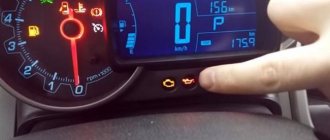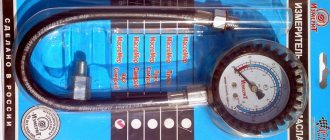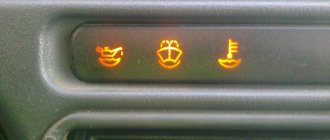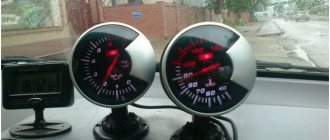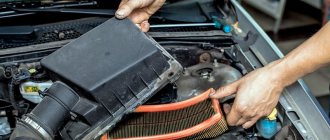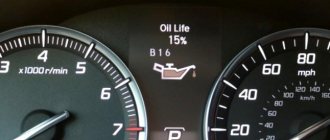Why does the oil pressure indicator light up on a warm VAZ-2112 engine?
Many motorists, especially on older carburetor cars, have come across the concept of the oil pressure warning light constantly burning. On the VAZ-2112, this problem mainly comes over the years, when the car has a sufficient service life. The reasons can be very different, from elementary to particularly complex, and therefore you need to know what to do.
Why does the oil pressure light come on at idle when the VAZ-2110 engine is warm?
One of the common problems with engine oil level today can be considered a malfunction of the oil pressure sensor. Its incorrect operation can be detected independently: in the case when the oil pressure lamp lights up when the engine is warm and idling. The driver can lightly press the gas pedal - the indicator will go out, but after releasing the pedal it will light up again.
In this case, the driver must immediately make sure that the cause of the malfunction lies precisely in the pressure sensor. If you carry out diagnostics, you can make sure that only the sensor is acting up, when the engine itself is normal.
Incorrect operation of the DDM may cause an indicator to appear on the instrument panel in the cabin
Causes
The oil pressure warning light comes on when the engine is warm
If we are talking about oil pressure, then naturally the problem is in the engine, namely in some components and parts. To determine the causes, it is necessary to know the structure and operation of the power unit, since without this it will be impossible to eliminate malfunctions. So, let’s look at the reasons why such a warning light may appear on the instrument panel:
- There is a malfunction in the sensor and wiring.
- The oil level has dropped below normal (see “how to check the oil level”).
- Signal to change the oil.
- The oil pump has failed.
- The malfunction is hidden in the cylinder head or directly in the cylinder block itself.
When all the reasons have been considered, it is necessary to move on to a consistent definition of the problem and options for eliminating it.
Solution methods
In order to eliminate an engine malfunction, you will need a set of tools, as well as knowledge of the structure of a car engine. So, let's look at how to fix the problem.
Sensor and wiring
Before you start panicking, you need to turn to the most harmless solution - a sensor. If it fails, the contacts close, so the lamp on the instrument panel can remain on constantly. To solve the problem, it is necessary to dismantle the sensor itself and check it, replacing it if necessary.
Removing the oil pressure sensor wire connector
If replacing the sensor did not yield anything, then you should check the wiring for insulation and continuity. Maybe a wire broke somewhere and that was causing the problem. Using a multimeter, it is worth diagnosing the wiring, which will take a few minutes. If a break is detected, in order not to go to extremes, it is necessary to clean the break site and solder the wiring, then insulate it from external factors. This can be done using a crimp tube or electrical tape.
Insufficient oil level
Insufficient oil level in the power unit can also cause the indicator to appear. This is due to the fact that with a small amount of lubricating fluid, the pressure in the engine itself also drops, and therefore the sensor transmits a signal to the ECU that the compression is not enough. To eliminate the malfunction, it is necessary to add oil to the engine until the level is between the maximum and minimum marks.
A dipstick that shows how much oil is in the engine
Change of oil
Another reason why the oil pressure indicator on the dashboard starts to light is the production of lubricating fluid. Thus, the loss of physicochemical and technical qualities can cause the pressure to drop to a minimum and lead to a signal. The way to solve the problem is to simply replace the lubricant and, accordingly, the filter, which, most likely, is also not in the best condition.
The oil filler neck is unscrewed to fill the liquid
Oil pump
More complex reasons and solutions for the appearance of an oil pressure indicator is the failure of the oil pump .
A pump malfunction makes it impossible for oil to circulate through the system , and therefore it is not possible to create the required pressure. So, its replacement will require disassembling and repairing half of the power unit, and therefore, as practice shows, motorists carry out major repairs of the internal combustion engine.
Oil pump removal diagram
Block head and power unit
The last reason that can catastrophically affect the loss of pressure in the main power unit is the malfunction of this unit . Thus, small gaps in the gaskets and regular loss of oil reduce the pressure, which in turn leads to increased wear of the entire assembly. Another reason for the drop in pressure in the engine and the activation of the indicator can be the wear and tear of the connecting rod and piston group, crankshaft and camshaft, as well as oil seals.
To eliminate the problem, you will have to carry out a complete overhaul of the engine. Of course, this procedure is expensive and can also take about a week.
Source
Sensor check
Engines of 2110 vehicles, regardless of their modification, are equipped with emergency pressure sensors of type MM 120, manufactured under catalog number 6022.3829.
Emergency oil pressure sensor type MM 120
Characteristics of the MM 120 sensor:
- rated voltage - 12 V;
- weight - 28 g;
- thread - M14x1.5;
- response pressure - 0.4±0.2 kgf/cm2;
- analogues - MM 120D, MM 120DM.
The emergency oil pressure sensors on the “tens”, as in principle on other VAZs, are very capricious devices and fail very often. Testing them at home is easy.
Tools and tools for checking:
- tire compressor or pump with pressure gauge;
- a piece of hose with an internal diameter of 10–12 mm and a length of 20–30 cm;
- 2 clamps;
- crosshead screwdriver;
- key for 21 or 22;
- car tester or control lamp with battery;
- dry rag.
The procedure for checking the sensor is as follows:
- Disconnect the negative terminal from the battery.
- We find the emergency pressure sensor on the engine.
- Disconnect the power cable from the sensor.
- Using a 21 or 22 wrench (the size of the sensor skirt may differ), unscrew the sensor from the cylinder head. In eight-valve engines, when unscrewing the sensor, a small amount of oil may leak out. If this happens, remove any stains with a rag.
- We put one end of the hose onto the sensor fitting and clamp the connection with a clamp.
- We put the other end of the hose on the fitting of the pump or compressor, and also fix it with a clamp.
- We connect the tester probes or “control” wires to the contact terminal of the sensor and to its body so that the device under test acts as a switch. In the initial position, our “switch” is turned on, so the control lamp should be on and the tester should beep, indicating that the circuit is closed.
- We begin to pump air, creating pressure in the sensor housing. According to the characteristics of the device, it should trigger when the pressure reaches 0.4±0.2 kgf/cm2. When the pressure rises to the desired value, the sensor should open the circuit and remain open until it drops.
- The sensor has tripped - you need to reduce the air supply to the hose and wait until it closes the circuit again. At this moment it is important to record the pressure value. If it is close to 0.4 kgf/cm2, everything is in order with the sensor.
The sensor should trigger when the pressure drops to 0.4 kgf/cm2
You can, of course, not waste your time checking it, but simply buy and install a new sensor. Moreover, it costs about 70 rubles.
Video: replacing the emergency oil pressure sensor
Problem with oil pressure in the VAZ-2112 1.5 16 cl engine
April 13, 2013, 09:02 #1
This is the problem: In the fall, I repaired the engine (VAZ 2112 1.5 l 16 cl), changed the pistons, liners, consumables, and after that, on a warm engine at idle speed, the oil light comes on. The service center said that the parts should be rubbed in and the light will stop burning. In winter, the lamp did not light up due to the fact that the engine operating temperature was lower than in the warm season. Spring came and the problem came out again. We measured the pressure at almost zero idle, at something like 0.1 rpm, it should always be at least 0.4. The sensor is ok. I’ll say right away that the oil pump, filter, and oil were changed. The “masters” shrug their shoulders, we don’t know what to do, this is the second car they have, they replaced the head on that one, and in general they say they assembled an almost new engine, the problem has not disappeared. Has anyone encountered this?
Lada 2112 1.5 l 16-cl › Logbook › The oil pressure light blinked at xx.
Hi all! I don’t even know where to start, I’m not in the mood at all. After the last oil change, but not immediately, after driving about 1000 km, the oil pressure light on a warm engine blinked at XX (this was about 7 months ago), I began to panic a little. The first thing, as everyone else probably does, is go to the store and buy an oil pressure sensor. I bought it, replaced it and no use. I went to the store again and bought some
I measured it and it showed about 0.8 at XX. Not enough, at 3000 - 4000 rpm the pressure is about 2 - 2.5. not enough either. I was a little confused. I started calling my friends, they advised me to change the oil pump and bearings, or just fill it with thicker oil and put the engine up for sale, there won’t be any problems! Nooo! I can’t do that and I’m not going to sell. Again to the store for a pump. I bought a pump (I didn’t take the inserts because I didn’t know what they were worth) and went to a friend’s garage to disassemble the engine (no photo, and there was no time to write notes) Well, here we go! I disassembled, changed everything, blew out the channels in the cylinder head and in the knee, drove on my own two for the liners (the liners are standard, the knee has never been sharpened) then reassembled (assembling a 16-cl. engine was such a chore, clean off the sealant, and then re-apply) Launch! The meter is already screwed onto the engine. When cold it showed about 1.5 at XX, if I’m not mistaken, as soon as the engine warmed up to 82 degrees, the pressure light blinked very rarely. oils It's a little better, but not as much as I wanted. So I went home. I was just tired and didn’t know what else she needed. My mother stayed with me like this for about a month. Then he calls and says: I warmed up the car (it was winter or autumn), the light does not go out at XX, when you touch the gas pedal with your foot it immediately goes out. Well, I think, fucked up! Disassemble the internal combustion engine again. I accidentally came across an article on a forum: a man had the same problem as me. He changed the oil injectors and the problem with the light bulb went away. A few days later I bought injectors with the hope that I have them in my internal combustion engine. When I disassembled the internal combustion engine the previous time, I didn’t pay attention to them (I didn’t even know that they were there) Photo from the Internet. Maybe it will be useful to someone.
Why the oil pressure light is on on a VAZ-2112 16 valves: reasons
On the instrument panel of the VAZ-2112 there is a special warning lamp that signals an emergency oil pressure inside the engine. In this article, we will tell you in detail what could be the reason for this lamp to light up, and how it can be quickly resolved.
The video shows a situation where the oil pressure light on a VAZ-2112 always comes on after the engine starts:
This situation occurred as a result of a major engine overhaul.
The purpose of the light bulb and why it lights up
In our article, I will try to tell you in detail about all the possible reasons why such an unpleasant phenomenon occurs, such as the oil pressure light on a VAZ 2110, as well as ways to determine the cause and methods for eliminating detected faults. So:
- The oil pressure warning light on the dashboard is an indicator that warns or, in extreme cases, confirms that something is wrong with the engine
- The list of possible reasons when the oil pressure light comes on on a VAZ 2110 may include the following: a problem in the operation of the engine, poorly performed repairs to the power unit, or a possible lack of regular, timely and necessary maintenance of the machine
- Whatever the discovered reason, it does not play a special role and the fact that you find out who is to blame for this malfunction will not bring you relief, and the cost of repairs will not decrease from this
- It is very important here to understand that you have a problem and you need to solve it urgently
- The main thing for you now is to detect the malfunction itself, due to which the oil pressure lamp on the VAZ 2110 lights up
- And taking actions to eliminate it as soon as possible, if you do not attach importance to this, the consequences can become much more complex and more global
- I present to your attention the main and common reasons why the oil pressure lamp on the VAZ 2110 indicates a malfunction
Causes
If you don’t trust the oil pressure sensor, or it’s a glitch in the instrument panel, you can measure the pressure yourself. All you need is a tool. Or auto service!
There may be several reasons for the malfunction and here are the most basic of them.
Oil level
The root cause of such a malfunction may be a simple lack of oil in the engine. If its level drops below normal, it must be topped up and this indicator checked. If the light went out, that was the reason. Don't forget to change and refill it on time.
Engine oil level is minimal
If the problem appeared after replacing the old oil with a new one and the problem did not disappear after 20 seconds after starting, then the reason lies in a non-working fuel filter, or the oil viscosity does not meet the manufacturer’s recommendations.
Oil pressure sensor
Another reason that may be observed is the oil pressure indicator. You can check its functionality by visual inspection or by shorting the ground wire to the engine. Do not rush to replace the oil pressure sensor with a new one, since the cause of the malfunction of the old one may be contamination of the channels. If the circuit is working properly, connect a working, new or cleaned sensor to the system in advance and connect the power. The lamp continues to light, which means you need to read below.
The light comes on during the cold season
The cause of the low oil pressure warning light on VAZ engines can also be negative ambient temperatures, but this is a completely normal phenomenon. This happens because the oil drains from all channels overnight and inevitably thickens. When the engine warms up, the warning light should go off. Therefore, during a “cold” start, the engine needs to fill all the lines and create the necessary pressure (what to do if there is no pressure in the engine?). Since the oil reaches the most important parts much earlier than the oil pressure sensor, wear on these parts is eliminated. During winter startup, the light can remain on for up to 3 seconds continuously.
Source
After the engine warms up, the oil pressure light comes on
The engine lubrication system involves supplying engine oil to loaded parts and components under a certain pressure, which is created by the oil pump. At the same time, a decrease in lubricant pressure for one reason or another is a critical malfunction that can quickly damage the power unit.
In this article we will talk about why the oil pressure comes on after the engine warms up, what causes and problems in the engine or lubrication system lead to this, and what the driver should do if the oil pressure comes on “hot”.
When the engine heats up, the oil pressure lights up: consequences for the engine
Let's start with the fact that any problems with lubricant pressure mean that the power unit is experiencing oil starvation. Simply put, the rubbing surfaces do not receive enough motor oil and their wear begins to increase. Oil also plays the role of a cleaner and cooler, washing away wear products and lowering the temperature in the area where the surfaces of rubbing pairs work.
Also, when the efficiency of the oil system decreases, knocks and noises appear in the engine, which subsequently lead to more serious damage or even engine seizure. In this case, jamming may well be accompanied by a “fist of friendship,” which greatly complicates the repair of the damaged unit and increases the overall costs of restoring the internal combustion engine.
The oil pressure light comes on after warming up: possible causes
If we talk about the situation when the oil pressure light comes on when the engine heats up, in this case you need to take into account that there are several main reasons:
- reduced lubrication level in the engine;
- motor oil is not suitable for the engine;
- the lubricating fluid has lost its properties;
- malfunctions of the lubrication system and internal combustion engine;
First of all, if the oil pressure is on, it is highly not recommended to operate such an engine until the problems are identified and completely eliminated. So, let's start with the simplest reason. We are talking about a banal decrease in the level of lubrication in the engine. Oil can leak out for various reasons, ranging from a broken oil pan to increased fuel consumption, oil leakage in the turbine area, etc.
Also, the unit itself may be worn out, that is, the engine “eats” oil and emits oil smoke due to problems with the CPG or valve stem seals. One way or another, if you do not monitor the lubricant level, if it drops before the power plant warms up, the oil remains thicker and the “cold” light may not light up.
However, after reaching operating temperatures and heating the lubricant, the material naturally liquefies and becomes more fluid. It is also worth remembering that the gaps between the mating parts in the engine are somewhat reduced, and it becomes more difficult for the oil pump to maintain the required pressure while pumping liquid oil through the system.
If we add to this a partial lack of lubrication, then it becomes clear why the pressure lamp begins to light up after the internal combustion engine has warmed up. To solve the problem, you need to add oil to the engine.
Then you can continue to add lubricant to the level for some time or immediately eliminate the leak (replacing oil seals, valve stem seals, piston rings) depending on the specific situation. If the engine is very worn out, then it is better to immediately undertake a comprehensive overhaul.
- Let's move on. In many cases, the cause of low pressure may be the oil itself. For example, if a lubricant is poured into the power unit, which according to SAE does not correspond to that recommended by the car manufacturer according to the manual (for example, the driver filled in 0W20 instead of 5W40), then after warming up the lubricant will be very liquid.
It is also important to consider that the lubricant may lose its properties for other reasons. For example, a significant increase in the planned replacement interval (instead of 10-15 thousand km, the lubricant worked for 20-30 thousand).
Also, loss of properties often occurs after mixing oil with antifreeze. In this case, it is appropriate to talk about a serious breakdown when coolant enters the oil system. This is often caused by cracks in the cylinder block and cylinder head, malfunctions and breakdowns of the head gasket, etc.
Tips and tricks
Please note that if no leaks are visible, and the oil level and its condition are normal, then before starting complex operations to disassemble the engine, experts recommend accurately measuring the oil pressure in the engine at the initial stage.
Quite often it happens that there is actually nothing wrong with the pressure, and the faults that lead to the warning light coming on are directly related to the wiring and the oil pressure sensor.
The contacts may oxidize over time, and the sensor may also fail. It is quite obvious that these elements also need to be checked first and foremost as part of diagnostic procedures.
How to check the oil pressure sensor in a VAZ-2110 yourself?
The verification procedure is available to every car owner - just follow the following diagnostic procedure:
The first thing you need to do is check the wires that go from the oil pressure sensor to the warning lamp (that is, the indicator itself).
You will need to take the sensor wire and place it against the engine.
If the light on the panel in the form of an oil can goes out immediately, it means that there is no short circuit in the wiring.
The sensor needs to be removed. If it is wet with oil, it means that the device has failed and is sending incorrect information to the instrument panel.
The oil pressure sensor will need to be replaced.
In the same case, if the device is dry, we can say that it is in working condition. Accordingly, it is necessary to replace the oil and oil filter.
